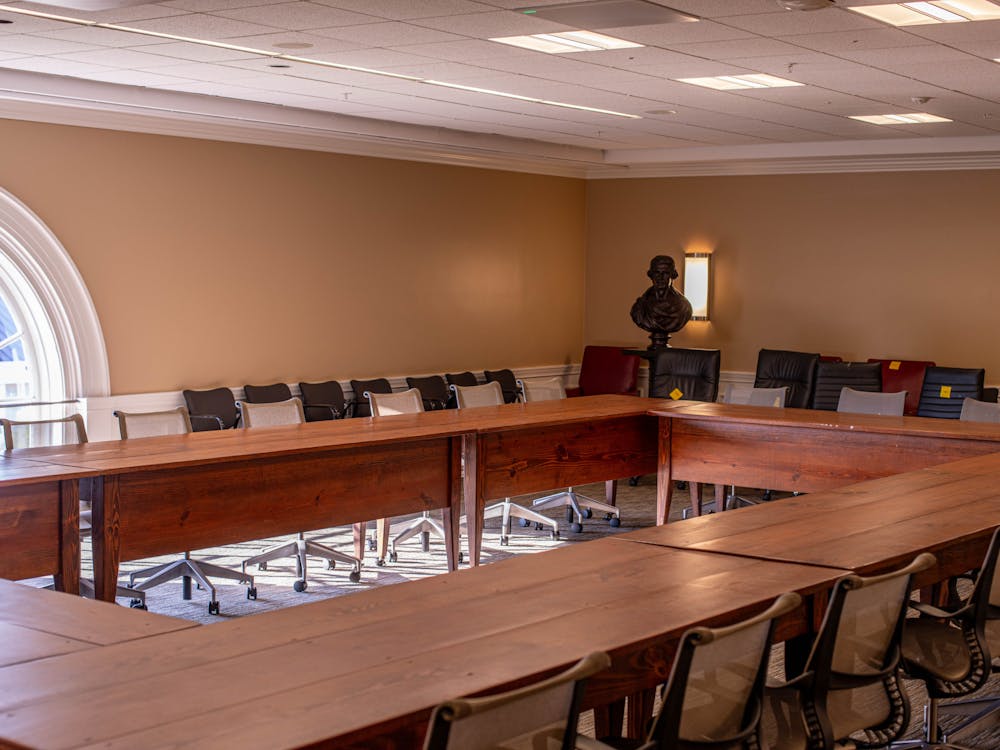The Board of Visitors met Thursday to discuss the University’s finances for the 2009-10 fiscal year. During the past fiscal year, the University experienced declines in its endowment, state appropriations and philanthropic giving, and University leaders and board members are now looking to account for these losses in funding.
Chris Brightman, head of UVIMCO, which manages the University’s endowment, said the fiscal year policy portfolio is down almost 30 percent. He said the University’s long-term, 10- or 20-year numbers remain positive, however.
“Endowments are reduced when we make distributions or payouts to support the endowed programs, or when our investments fall in value as has happened in recent months,” said Yoke San Reynolds, vice president and chief financial officer.
During normal economic conditions, “spending policy calls for a steady increase of our [endowment] payout as long as the resulting payout is not lower than 4 percent of the endowment’s market value and not higher than 6 percent of the endowment’s market value,” Reynolds said. “These upper and lower limits help ensure that we do not spend too much or too little of our endowment.”
A significant change in the endowment’s market value, though, like the 27 percent decrease seen since June 30, 2008, means that the University has to reset the endowment’s payout level, Reynolds said.
Though the endowment’s status was discussed at the Board meeting Thursday, members did not make a decision about resetting the payout level. Leonard Sandridge, executive vice president and chief operating officer, said he thinks it is unlikely the Board will make a decision about possible payout level changes before September, adding that he believes BOV members will likely try to sustain or reduce the current payout level.
During the past year, the University’s endowment was not the only source of funding to see declines. State funding also fell, as commonwealth leaders enacted General Fund cuts that will affect the University’s operations.
In terms of reducing the impact of these losses, President John T. Casteen, III said he expects the federal government’s American Recovery and Reinvestment Act to provide the University money. The University will receive a combined $10.7 million in AARA funds in 2009 and 2010 to help offset Gov. Tim Kaine’s recommended $23.1 million General Fund cut, leaving a net reduction of $12.4 million, he said.
The University also saw a reduction in philanthropic giving during the past fiscal year, Casteen said. The University and its related foundations received more than $172 million for the fiscal year through February 28, Casteen said, adding that this is a decrease of more than $31 million or 15.51 percent from the previous fiscal year.
Although the combined value of gifts to the University decreased, gifts to the Rector and BOV, Nursing School, the Engineering School, the School of Continuing and Professional Studies, the Darden School, the Claude Moore Health Sciences Library, the Center for Politics and the Law School increased during the last fiscal year, despite the economic downturn, Casteen said. To further increase philanthropic giving during the next fiscal year, the University plans to pay more visits to potential donors and hold more fundraising events.
Board members also agreed that the University will issue bonds to increase financing. Though the decision to issue bonds was not controversial among Board members, the decision between safe fixed-rate bonds and the unpredictable but potentially high-rewarding variable bonds sparked considerable discussion. The Board ultimately decided to issue fixed-rate bonds, which lock in an interest during the bonds’ life, which usually lasts between 20 to 30 years, Reynolds said. She added that although fixed-rate bonds have historically been more expensive than variable bonds — which have interest values that can fluctuate throughout time — they are more predictable.
“We are now issuing $250 million worth of bonds and because of uncertainties of the credit market, we are going to issue them fixed rate,” Reynolds said.
Discussion of a new federal bond program also raised some debate. Reynolds said BOV members will consider whether to issue conventional tax-exempt bonds or to use the Build America Bond program in the future.
Though the University normally issues tax-exempt bonds as part of the federal stimulus package, Sandridge said the University now is considering the Obama administration’s Build America Bond program, which offers bonds with a provision for an interest subsidy.
The program’s low interest rate would be advantageous to the University, Sandridge said, should the University qualify under the program and meet the government’s timeline for introducing the program.
Sandridge said, however, that “until we know what the details are [and what] strings are attached, we won’t make a decision to go with that option,” adding that if the Board chooses not to participate in the Build America Bond program, it will continue to issue tax-exempt bonds.
Reynolds noted that the change in the economy has not hurt — and may have even helped — the borrowing capability of the University because of its Triple A rating. University spokesperson Carol Wood said a Triple A rating tells investors that “the University is considered to be a good, solid and safe investment when issuing bonds to cover.”
Wood noted that this is a position the University has held since 2003.
“It’s a huge accomplishment for an institution to obtain such a rating, but it’s especially significant in a difficult economic environment to maintain the rating,” she said.
The University is one of only three public universities in the country to hold this rating, including the University of Texas System and the University of Michigan, Reynolds said.
Despite the changes in the financial climate, Sandridge said he believes the University is managing its situation and positioned well for the future.
“The University tries to plan for downturns of this nature,” he said. “We try to anticipate them, plan for them and manage to them.”






